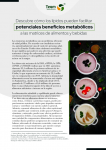Polyphenols to boost oil quality from rice bran
detrimental effects of rice bran lipase and make the bran an
interesting source of edible oil, Indian researchers report.
Writing in the Journal of Food Science , researchers from Mysore-based Central Food Technological Research Institute report that addition of chlorogenic acid (CGA) and caffeic acid (CA) reduce the activity of the enzyme and could help the byproduct fulfil its potential for use as a food ingredient and oil source.
Global oilseed production for 2005-06 was projected at a record 389 million tonnes with non-US production predicted to reach 292.5 million tonnes, according to the American Soybean Association (ASA).
However, demand for edible oils in countries like India is not met by the supply, with annual requirements of about five million tons.
Oilseed production in some Asian countries is unable to meet this demand.
In background information in the article, the researchers report that while rice bran protein is gaining interest in the food industry, the use of the brain as an oil source is limited by the presence of the lipase enzymes which produce high levels of free fatty acids.
These fatty acids are said to reduce the quality of the oil and make it unsuitable for use as an edible oil source.
The new study reports however that the detrimental effects of rice bran lipase (RBL) may be inhibited by addition of the polyphenols, with the inhibitory effect dependent on the concentration of polyphenol used.
Indeed, at higher concentrations (60 micromoles) the activity of the lipase was inhibited by 22 and 56 per cent for CGA and CA, respectively, while only limited inhibition was observed at lower concentrations.
"These activity results clearly demonstrate that the RBL inhibition is more pronounced in the case of CA than CGA," wrote the authors.
The polyphenols were reported to act via hydrogen and hydrophobic interactions with the enzyme, and thereby preventing the oxidation of the rice bran oil.
"These inactivation phenomena of RBL by naturally occurring plant secondary metabolites provide very useful information for prevention of lipolysis occurring in rice bran, and this method of polyphenol treatment will have an advantage compared to physical and chemical treatments," wrote the researchers.
"This in turn benefits the food industry, such as the rice milling industry in the production of good quality rice bran oil.
"This detailed investigation of the inhibitory effect of CGA and CA on RBL also leads to the development of the processes toward stabilization treatment of rice bran and in turn the nutritional quality of protein concentrates," they concluded.
The oil content of rice bran is reported to be between 15 and 25 per cent, while the moisture content is low (around six per cent).
The bran is gaining interest in the food industry because it also contains proteins, vitamins, and nutraceuticals.
Source: Journal of Food Science Published online ahead of print, doi: 10.1111/j.1750-3841.2007.00488.x " Mechanism of Inhibition of Rice Bran Lipase by Polyphenols: A Case Study with Chlorogenic Acid and Caffeic Acid" Authors: M.P. Raghavendra, P.R. Kumar, and V. Prakash














